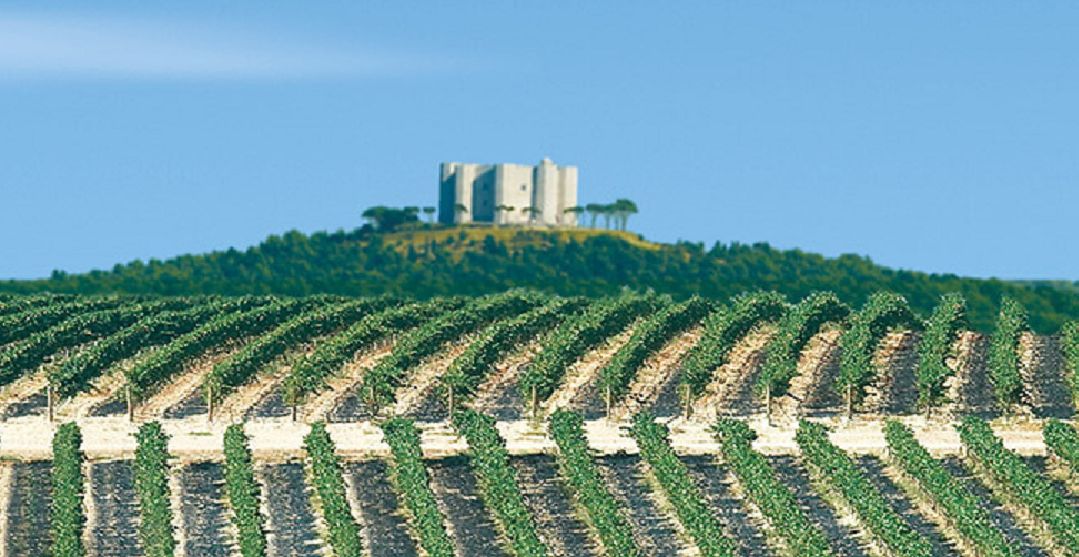Results
2,284 Results
Loading more Results ...
Loading more Results ...
Wine regions in Apulia 41 growing regions
Description to Apulia
The region of Apulia (Italian: Puglia) with its capital Bari lies deep in the south of Italy on the Adriatic coast. The elongated region consists of the spur (the Gargano Mountains) and the heel (the Salento Peninsula) of the boot. The name goes back to the Apuli; a tribe of the Oscians. The area is one of the oldest wine-growing regions in the world, as the Phoenicians and Greeks planted vines here 3,000 years ago. The Romans particularly appreciated the wine from Tarentum (port city of Taranto) and the poet Horace (65-8 BC) described the area as a place of "eternal spring". The Staufer Emperor Frederick II (1194-1250) was King of Sicily from 1198 and stayed in Italy for 28 years. Near Bari, he had the Castel del Monte built with an octagonal main building, around which eight likewise octagonal towers are grouped.

In contrast to the other southern regions of Italy, there are hardly any mountains, but the landscape consists of plateaus and lowlands. The climate is hot and dry with little rainfall, so that artificial irrigation is sometimes necessary. The soils consist mainly of limestone, clay and sandstone. There are many autochthonous grape varieties. The red wine varieties cover about 75% of the area, the most important are Aglianico, Aleatico, Barbera, Bonifacienco (also Carenisca or Caricagiola = Parraleta), Bombino Nero, Cabernet Franc, Cabernet Sauvignon, Lambrusco Maestri, Malbech (Cot), Malvasia Nera di Lecce od. Malvasia Nera di Brindisi, Merlot, Montepulciano, Notardomenico, Ottavianello (Cinsaut), Pinot Nero (Pinot Noir), Primitivo (Tribidrag), Sangiovese, Susumaniello and Uva di Troia (Nero di Troia).
The most important white wine varieties are Bianco d'Alessano, Bombino Bianco, Chardonnay, Falanghina Beneventana, Falanghina Flegrea (Falanghina), Fiano, Francavidda, Greco di Tufo (Greco), Impigno, Malvasia Bianca di Candia, Malvasia Bianca od. Malvasia Toscana or Malvasia Bianca Lunga, Minutolo, Moscato or Moscato Bianco or Moscato di Trani (Muscat Blanc), Pampanuto, Pinot Bianco (Pinot Blanc), Pinot Grigio (Pinot Gris), Sauvignon (Sauvignon Blanc) and Verdeca.
The vineyards cover 88,000 hectares of vines. Puglia produces the most wine in Italy. That is why the region is also called the "wine cellar of Italy or Europe". Together with Sicily, it is at the top of the Italian wine production volume. The best qualities grow on the Salento peninsula, climatically favoured by the proximity of the Adriatic and Ionian Seas. Quality wines, however, account for only less than 10% of the volume. A large part of the wines is used for the distillation of industrial alcohol and for the production of simple mass wines. The IGT (country wines), DOC and DOCG (quality wines) areas in Puglia are:
- Aleatico di Puglia (DOC)
- Alezio (DOC)
- Barletta (DOC)
- Brindisi (DOC)
- Cacc'e Mmitte di Lucera (DOC)
- Castel del Monte (DOC)
- Castel del Monte Bombino Nero (DOCG)
- Castel del Monte Nero di Troia Riserva (DOCG)
- Castel del Monte Rosso Riserva (DOCG)
- Colline Joniche Tarantine (DOC)
- Copertino (DOC)
- Daunia (IGT)
- Galatina (DOC)
- Gioia del Colle (DOC)
- Gravina (DOC)
- Leverano (DOC)
- Lizzano (DOC)
- Locorotondo (DOC)
- Martina Franca or Martina (DOC)
- Matino (DOC)
- Moscato di Trani (DOC)
- Murgia (IGT)
- Nardò (DOC)
- Negroamaro di Terra d'Otranto (DOC)
- Orta Nova (DOC)
- Ostuni (DOC)
- Primitivo di Manduria (DOC)
- Primitivo di Manduria Dolce Naturale (DOCG)
- Puglia (IGT)
- Rosso di Cerignola (DOC)
- Salice Salentino (DOC)
- Salento (IGT)
- San Severo (DOC)
- Squinzano (DOC)
- Tarantino (IGT)
- Tavoliere delle Puglie or Tavoliere (DOC)
- Terra d'Otranto (DOC)
- Valle d'Itria (IGT)
Classified wine producers in Apulia 10
find+buy for Apulia 85
Recent wines 575
 Vinicola Savese S.n.c.
— Apulia
2020 Primitivo di Manduria DOP "Ajanoa"
Up to 25.00 €
Vinicola Savese S.n.c.
— Apulia
2020 Primitivo di Manduria DOP "Ajanoa"
Up to 25.00 €

 Vinicola Savese S.n.c.
— Apulia
2020 Primitivo di Manduria DOC Riserva "Tradizione del Nonno"
Up to 30.00 €
Vinicola Savese S.n.c.
— Apulia
2020 Primitivo di Manduria DOC Riserva "Tradizione del Nonno"
Up to 30.00 €

The most important grape varieties
More information in the magazine
- Time of change Wine country South Tyrol
- Paradisiacal times! Tasting: European sparkling wines for the festive season
- Perfection is possible Tasting: Barolo 2019
- Elegance wins Barbaresco
- Colli Euganei: where even the Romans enjoyed wellness Wine, thermal baths and volcanic cones
- The foam we love Lambrusco
- Lessini Durello: A sparkling wine with a future Diletta Tonello from the protection consortium on an experiment with consequences
- The Two from the Volcano Soave and Lessini Durello
- Terre del Marchesato Collection of the Year 2022 - Tuscany
- Reyter - Christoph Unterhofer Discovery of the Year 2022 - South Tyrol

